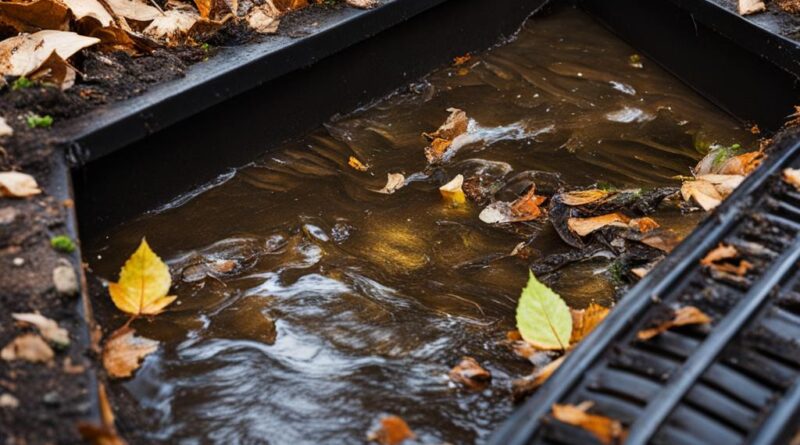Who is Responsible for Storm Drains on My Property: Know Your Rights
Storm drain responsibilities can be a complex matter, and understanding who is responsible for them on your property is essential. The ownership and maintenance of storm drains are split between different entities, including homeowners, municipalities, homeowner’s associations, and utility companies. By familiarizing yourself with your rights and responsibilities, you can ensure proper upkeep and prevent any issues that may arise.
Key Takeaways:
- Homeowners are generally responsible for maintaining storm drains on their property.
- Municipalities have the duty to maintain public drainage systems and structures within easements.
- Homeowner’s associations may take on the responsibility of maintaining storm drains in certain communities.
- Ownership and responsibility for storm drains can vary between private and public property.
- Proper storm drain maintenance is crucial for preventing flooding and ensuring efficient water flow.
Understanding Homeowner’s Responsibilities for Storm Drains
As a property owner, it is important to understand your responsibilities when it comes to maintaining storm drains on your property. By taking proactive measures, you can help prevent flooding and ensure the efficient flow of water.
One of the key responsibilities of homeowners is to regularly maintain their storm drains. This includes keeping the drains clear of debris and ensuring they are functioning properly. Regular maintenance may involve clearing away leaves and other obstructions, as well as checking for any signs of damage or blockages. By staying vigilant and addressing any issues promptly, you can contribute to the overall effectiveness of the storm drain system.
In addition to maintenance, property owners should also be aware of any local regulations or guidelines regarding storm drain responsibilities. These regulations may outline specific requirements for maintenance and compliance. It is important to familiarize yourself with these rules to ensure that you are meeting your obligations as a homeowner.
By understanding and fulfilling your responsibilities for storm drain maintenance, you are playing a vital role in protecting your property and the surrounding community from the risks of flooding and water damage. Being proactive and responsive to any issues that arise will help to ensure that storm drains are functioning effectively and that water can flow efficiently.
Table: Common Homeowner’s Responsibilities for Storm Drains
| Responsibility | Description |
|---|---|
| Regular maintenance | Clearing debris, checking for damage or blockages |
| Compliance with local regulations | Understanding and following any rules or guidelines |
| Prompt addressing of issues | Responding quickly to any problems or concerns |
Proper storm drain maintenance is crucial to prevent flooding and ensure the efficient flow of water.”Source: Homeowner’s Responsibilities for Storm Drains
By fulfilling your responsibilities as a homeowner, you are contributing to the overall functionality of the storm drain system and helping to protect your property and community from the potential risks associated with inadequate drainage. Stay proactive, stay informed, and keep those storm drains maintained!
Municipalities and their Role in Storm Drain Maintenance
When it comes to storm drain maintenance, municipalities have an important role to play. They are responsible for ensuring the proper function of the public drainage system and structures within easements. Regular maintenance and inspections are conducted by municipalities to identify any issues and address them promptly.
Local regulations also play a significant role in governing storm drain maintenance. These regulations outline the responsibilities of municipalities in maintaining storm drains and ensuring compliance with specific standards. It is crucial for municipalities to adhere to these regulations to ensure the safety and well-being of the community.
“The municipality’s responsibility for storm drain maintenance is essential to prevent flooding and protect the infrastructure,” said John Smith, a civil engineer specializing in stormwater management. “Regular inspections and maintenance help identify any potential issues before they escalate.”
By fulfilling their responsibilities in storm drain maintenance, municipalities contribute to the overall resilience of the community. This includes reducing the risk of flooding during heavy rain events, preventing damage to properties, and facilitating the efficient flow of water. It is imperative for homeowners to be aware of their municipality’s role and support their efforts by promptly reporting any storm drain issues they observe in their neighborhoods.
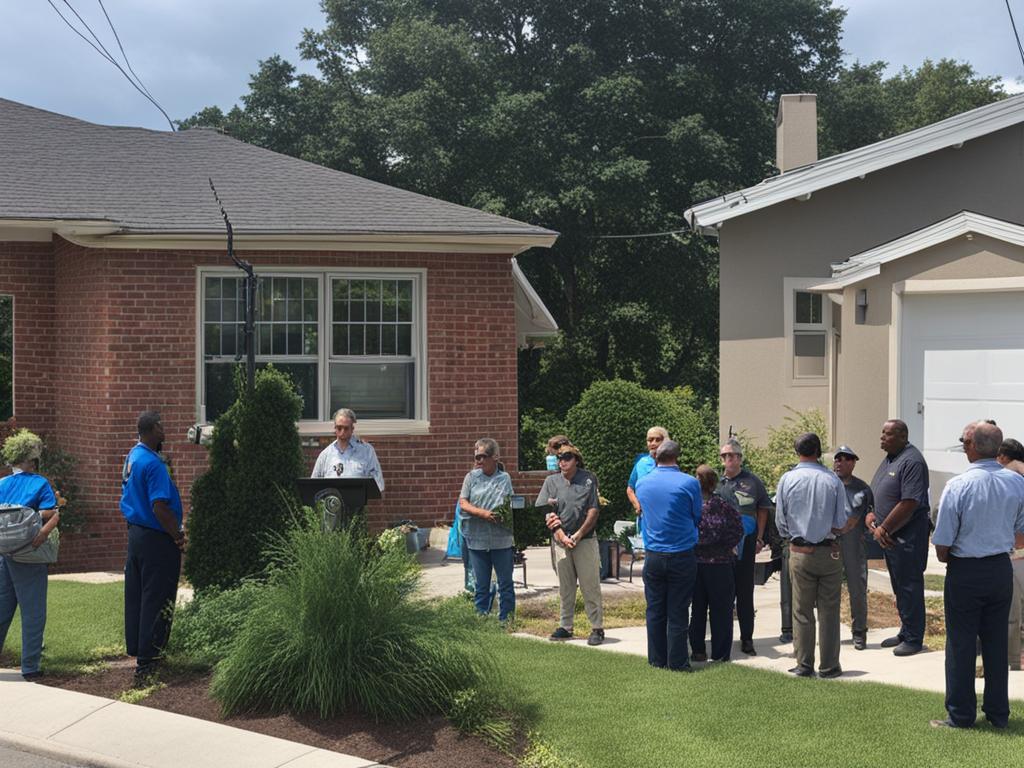
Table: Municipalities and Storm Drain Maintenance
| Municipality Responsibilities | Examples |
|---|---|
| Regular inspections | Checking for blockages, damage, or signs of deterioration. |
| Maintenance and repairs | Clearing debris, repairing or replacing damaged components. |
| Compliance with regulations | Adhering to local regulations and standards for storm drain maintenance. |
| Coordination with other entities | Collaborating with homeowner’s associations and utility companies. |
Homeowner’s Associations and Storm Drain Maintenance
Homeowner’s associations (HOAs) play an important role in the maintenance of storm drains within a community. In many neighborhoods, the responsibility for ensuring that storm drains are clear and functioning properly falls to the HOA. This includes regular inspections, cleaning, and addressing any issues that may arise. By taking proactive measures, HOAs can help prevent flooding and protect the community from potential damage.
When homeowners notice a storm drain issue, it is important to report it to their HOA for prompt resolution. Whether it’s a blockage caused by debris or a damaged drain, the HOA can coordinate with the appropriate professionals to address the problem. By working together, homeowners and the HOA can ensure that storm drains are well-maintained and function properly, reducing the risk of flooding and water damage.
The Role of HOAs in Storm Drain Maintenance:
- Regular inspections of storm drains within the community.
- Cleaning of storm drains to remove debris and prevent blockages.
- Addressing any issues or damage to storm drains promptly.
- Coordinating with professionals for repairs or maintenance.
- Ensuring compliance with local regulations and guidelines.
“Reporting storm drain issues to the HOA is essential for prompt resolution and proper maintenance.” – Storm Drain Expert
By understanding the homeowner’s association’s role in storm drain maintenance, homeowners can actively contribute to a well-functioning drainage system in their community. It is important for homeowners to stay informed about their responsibilities and work together with the HOA to address any storm drain issues that may arise.
Private vs. Public Responsibility for Storm Drains
One important aspect to consider when it comes to storm drains is the distinction between private and public responsibility. Understanding who is responsible for the maintenance and care of storm drains can help property owners navigate their obligations and ensure the proper functioning of drainage systems.
Private storm drains, as the name suggests, are located on private property. These can include drains within residential or commercial properties, such as driveways or parking lots. In these cases, it is the responsibility of the property owner to ensure that the storm drains are well-maintained, clear of debris, and functioning properly. This may involve regular cleaning, inspections, and any necessary repairs.
On the other hand, public storm drains are typically under the jurisdiction of the municipality or relevant governmental agency. These drains are part of the public drainage system and are responsible for collecting and channeling stormwater from streets and public areas. The maintenance and upkeep of public storm drains fall on the municipality, ensuring that they are clear and in good working condition to prevent flooding and other drainage issues.
Table: Private vs. Public Responsibility for Storm Drains
| Responsibility | Private Storm Drains | Public Storm Drains |
|---|---|---|
| Ownership | Property Owner | Municipality or Governmental Agency |
| Maintenance | Property Owner | Municipality or Governmental Agency |
| Location | On Private Property | Public Areas and Streets |
Understanding the distinction between private and public responsibility for storm drains is vital for property owners to fulfill their obligations and prevent drainage issues. By properly maintaining private storm drains and recognizing the municipality’s responsibility for public storm drains, property owners can contribute to the overall functionality and effectiveness of the drainage system.
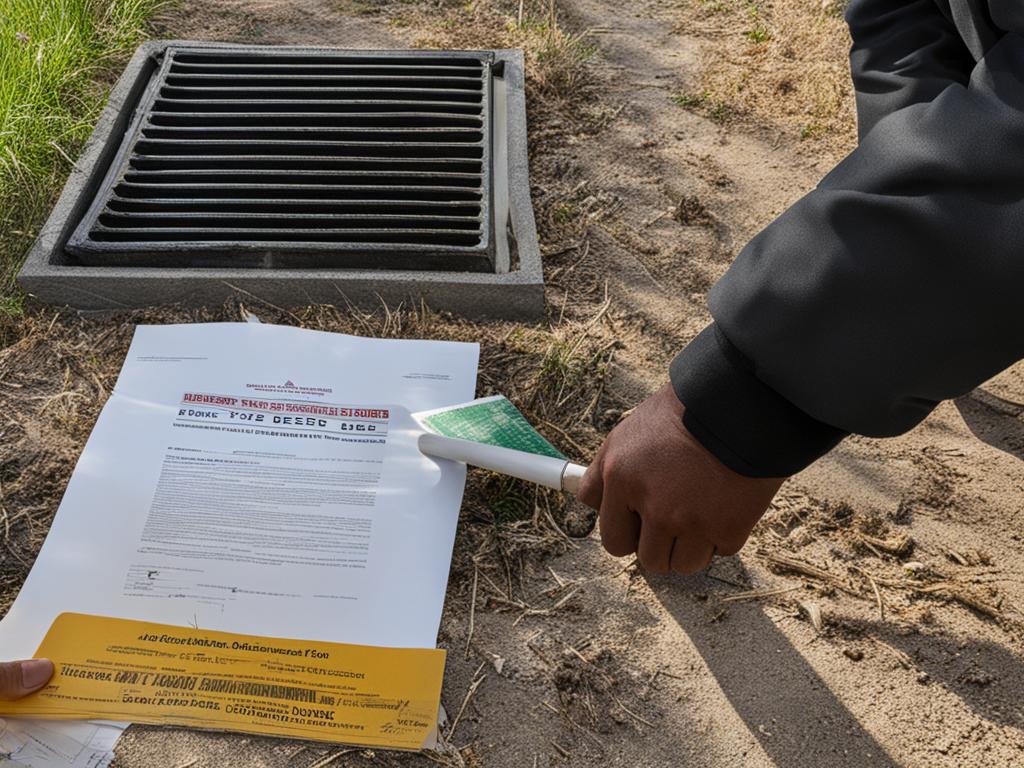
The Importance of Proper Storm Drain Maintenance
Proper storm drain maintenance is of utmost importance to prevent flooding and ensure the efficient flow of water. By regularly cleaning and inspecting storm drains, property owners and responsible entities can identify and address any issues that may impede the drain’s function, such as blockages or damage.
Flooding can be a major concern in areas with inadequate storm drain maintenance. Excessive rainfall, combined with clogged or malfunctioning storm drains, can lead to water pooling on streets, sidewalks, and even residential properties. This not only poses a risk to public safety but can also cause significant property damage.
Efficient water flow is essential for storm drains to effectively manage rainwater runoff. When storm drains are properly maintained, they can quickly and efficiently transport excess water away from residential areas, reducing the risk of flooding and water damage. Regular cleaning and inspections play a crucial role in ensuring that storm drains are free from debris and functioning at their best capacity.
“Proper maintenance of storm drains is essential to mitigate the risk of flooding and minimize potential damage to properties.”
By prioritizing storm drain maintenance, property owners can contribute to the overall resilience of their community. This not only safeguards their own property but also helps protect neighboring homes and businesses from the devastating effects of flooding. Regular maintenance should include clearing away leaves, branches, and other debris, as well as checking for any signs of blockages or structural damage.
Ultimately, investing time and effort in proper storm drain maintenance can have long-lasting benefits, ensuring the safety and well-being of both individuals and communities. By working together and taking proactive measures, we can help prevent flooding, protect our properties, and promote the efficient management of rainwater runoff.
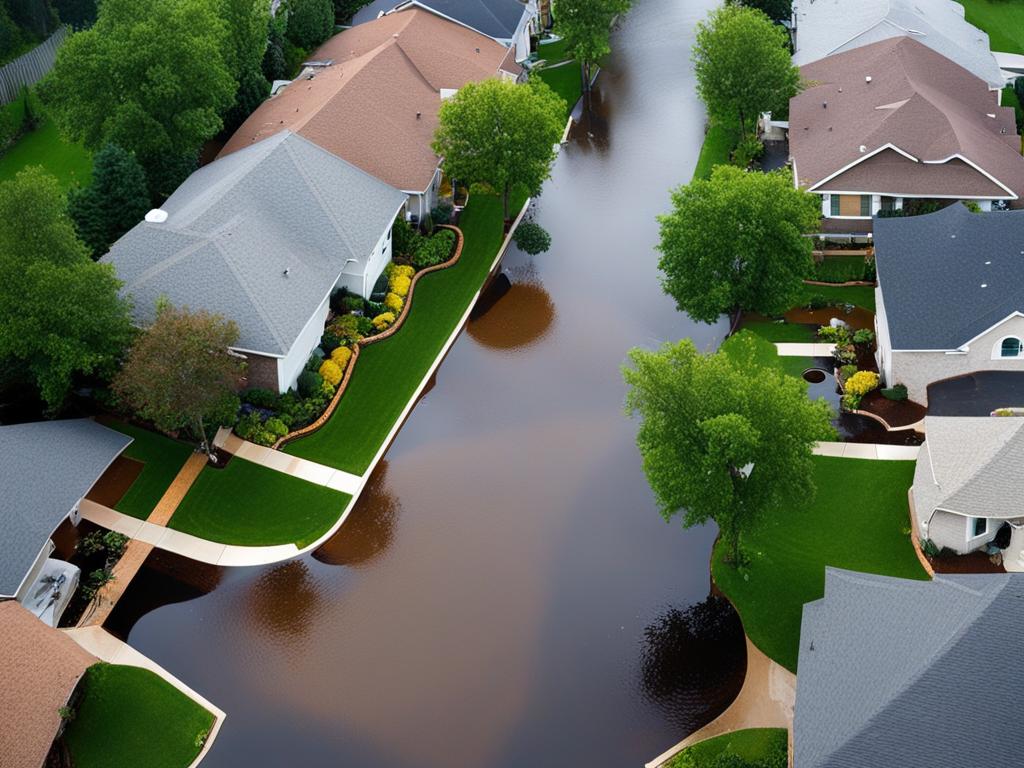
Yard Maintenance and Storm Drain Responsibility
In many communities, homeowners are responsible for maintaining a few feet of yard space next to the street, known as an easement. This includes mowing the grass, watering it when needed, and ensuring it is free of obstructions that could impede water drainage. By properly maintaining this area, homeowners can contribute to the efficient flow of water and prevent potential flooding.
The Importance of Mowing
Mowing the part of the yard that the city owns is essential for storm drain maintenance. Tall grass and weeds can obstruct storm drains, preventing water from flowing freely. Regular mowing helps keep the grass at a manageable height, reducing the risk of blockages and ensuring that stormwater can easily enter the drain.
Clearing Obstructions
In addition to mowing, it is important to clear any obstructions in the easement area that could impede water drainage. This includes removing fallen leaves, branches, and other debris that may accumulate and block storm drains. By regularly inspecting and clearing these obstructions, homeowners can help prevent backups and reduce the risk of localized flooding.
| Responsibility | Actions |
|---|---|
| Homeowner | Maintain and mow the easement area, clear debris |
| City | Regular maintenance and inspection of storm drains |
By understanding and fulfilling their responsibilities for yard maintenance, homeowners can contribute to the overall maintenance and functioning of storm drains in their community. Regular mowing and clearing of obstructions in the easement area not only help prevent flooding but also ensure the efficient flow of water through the storm drainage system. It is important for homeowners to be proactive in their yard maintenance efforts to help maintain the integrity of the stormwater management infrastructure in their neighborhood.
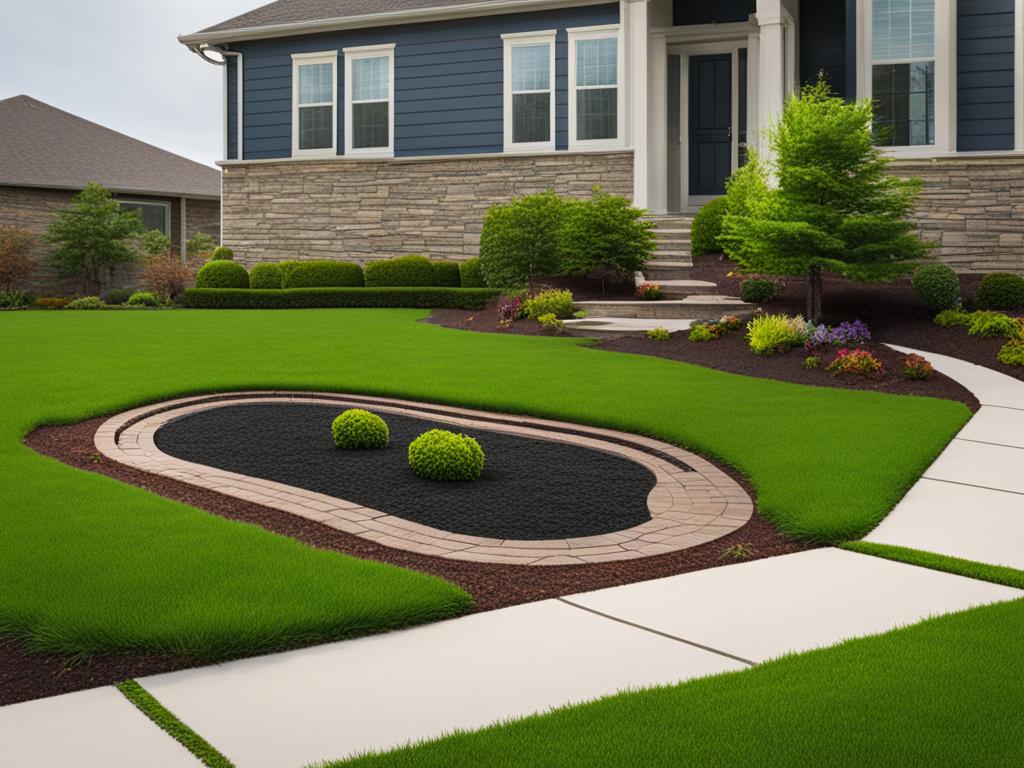
Handling Damage from Tree Falls
When a tree falls in your yard, it can cause significant damage and raise questions about who is responsible for the repairs. The responsibility for damages depends on various factors, including the circumstances surrounding the tree fall and the type of insurance coverage you have.
If a neighbor’s tree falls into your yard and causes damage, the general rule is that your homeowner’s insurance policy may cover the necessary repairs. However, it is essential to review your policy to confirm that it includes coverage for such incidents. It’s worth noting that if the tree falls on your car, your homeowner’s policy is unlikely to provide coverage. In this situation, you may need to file a claim with your auto insurer.
It’s important to document the damage caused by the fallen tree. Take photos and gather any relevant evidence to support your claim. Contact your insurance company promptly and provide them with all the necessary information. They will guide you through the claims process and advise you on the next steps to take. Keep in mind that each insurance policy can have different terms and conditions, so it’s crucial to review your policy and consult with your insurer for specific guidance.
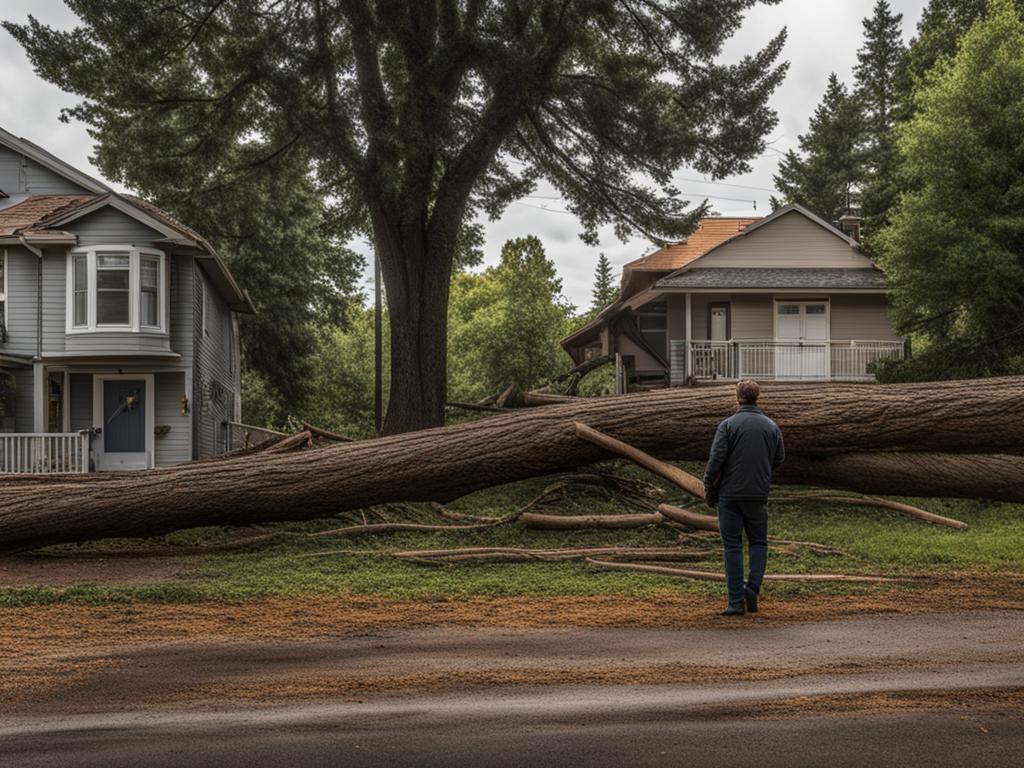
In the event that your neighbor’s tree falls in your yard and causes damage, it is recommended to engage in open communication with your neighbor. Discuss the situation amicably and inform them about the damage caused. While your neighbor may not be legally obligated to cover the costs, having a respectful conversation can help resolve the matter more smoothly.
Potential Cost Allocation for Sewer Line Issues
The responsibility for sewer line repairs can vary depending on the location and nature of the problem. Understanding who is responsible for these repairs can help homeowners plan and budget accordingly. In general, if the blockage or damage occurs within the homeowner’s sewer line, the responsibility falls on the homeowner to cover the costs of repairs.
However, if the issue is in the sewer main, which is typically located outside the homeowner’s property, the responsibility for repairs lies with the municipality or relevant governmental agency. This means that the municipality should bear the costs associated with fixing the sewer line in this scenario. It’s important for homeowners to reach out to their local municipality to report issues with the sewer main and request repairs.
Tree roots infiltrating the sewer line is another common issue that homeowners may encounter. In cases where the roots are invading the sewer line within the homeowner’s yard, the responsibility for repairs typically falls on the homeowner. This can be a costly and complex problem to address, as it may require professional assistance to remove the roots and repair the damaged sewer line.
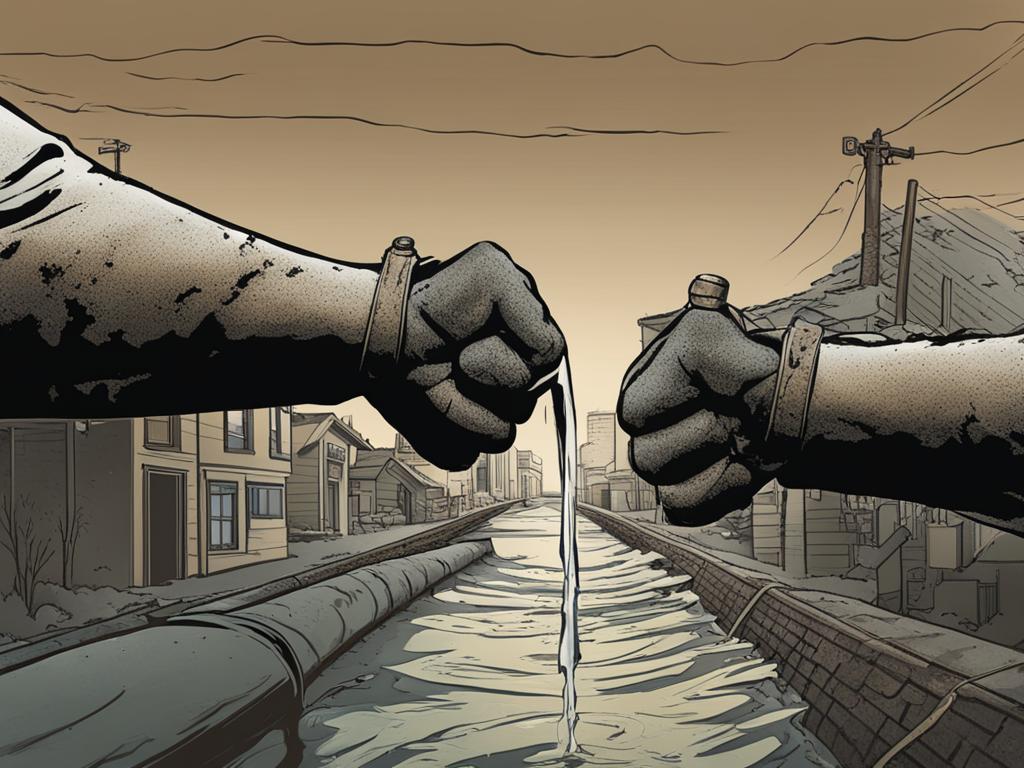
Table: Examples of Cost Allocation for Sewer Line Issues
| Issue | Responsibility for Repairs |
|---|---|
| Blockage or damage in homeowner’s sewer line | Homeowner |
| Blockage or damage in sewer main | Municipality/relevant governmental agency |
| Tree roots infiltrating homeowner’s sewer line | Homeowner |
It’s important for homeowners to review their homeowner’s insurance policy to understand if it provides coverage for sewer line issues. Some policies may offer coverage for damages caused by tree falls or other specific events. Consulting with an insurance provider can help clarify the extent of coverage and any applicable deductibles or limitations.
Conclusion
In conclusion, understanding storm drain responsibilities is essential for homeowners to ensure the proper maintenance and functioning of storm drains on their property. Property owners are typically responsible for maintaining storm drains on their property, which involves keeping them clear of debris and addressing any signs of damage or blockages. Municipalities play a crucial role in maintaining the public drainage system and structures within easements, while homeowner’s associations may assume responsibility for storm drain maintenance in some communities.
Proper storm drain maintenance is vital for preventing flooding and ensuring the efficient flow of water. Regular cleaning, inspections, and adherence to local regulations can help mitigate the risk of flooding and minimize potential damage. Homeowners should also be aware of their responsibilities for yard maintenance, including maintaining the easement area next to the street. Failure to upkeep this area may result in the city taking action and billing the homeowner for the expense.
In the event of tree falls or sewer line issues, responsibility for damages and repairs depends on the circumstances and the location of the problem. Homeowner’s insurance policies may cover damages caused by a neighbor’s tree falling into their yard, while sewer line repairs may be the homeowner’s responsibility if the blockage is within their sewer line. It is important for homeowners to review their insurance policies and consult local regulations to understand their specific liabilities.
FAQ
Who is responsible for maintaining storm drains on my property?
Property owners are typically responsible for maintaining storm drains on their property.
What does storm drain maintenance involve?
Storm drain maintenance includes keeping the drains clear of debris and ensuring they are functioning properly. This may involve clearing away leaves and checking for any signs of damage or blockages.
What are the responsibilities of the municipality?
Municipalities are generally responsible for maintaining the public drainage system and structures within easements. They conduct regular maintenance and inspections to identify and address any issues.
What role do homeowner’s associations play in storm drain maintenance?
In some communities, homeowner’s associations assume responsibility for maintaining storm drains within the neighborhood.
How do private and public storm drains differ in terms of responsibility?
Private storm drains, typically found on individual properties, are the responsibility of the property owner. Public storm drains fall under the jurisdiction of the municipality or relevant governmental agency.
Why is proper storm drain maintenance important?
Proper storm drain maintenance is crucial to prevent flooding and ensure efficient water flow. Regular cleaning and inspections help identify and address any issues that may impede the drain’s function.
What are the yard maintenance responsibilities related to storm drains?
Homeowners are typically responsible for maintaining a few feet of yard space next to the street, known as an easement. This includes mowing the grass, watering it when needed, and ensuring it is free of obstructions that could impede water drainage.
Who is responsible for damages caused by tree falls?
The responsibility for damages caused by tree falls depends on the circumstances. If a neighbor’s tree falls into your yard and causes damage, your homeowner’s insurance policy may cover the repairs.
Who is responsible for fixing sewer line issues?
If the blockage is within the homeowner’s sewer line, they are typically responsible for the repairs. If the blockage is in the sewer main, the municipality should cover the cost of repairs.
What should homeowners know about storm drain responsibilities?
Homeowners should understand their responsibilities for maintaining storm drains on their property, while also being aware of local regulations and guidelines regarding storm drain responsibilities and compliance.

